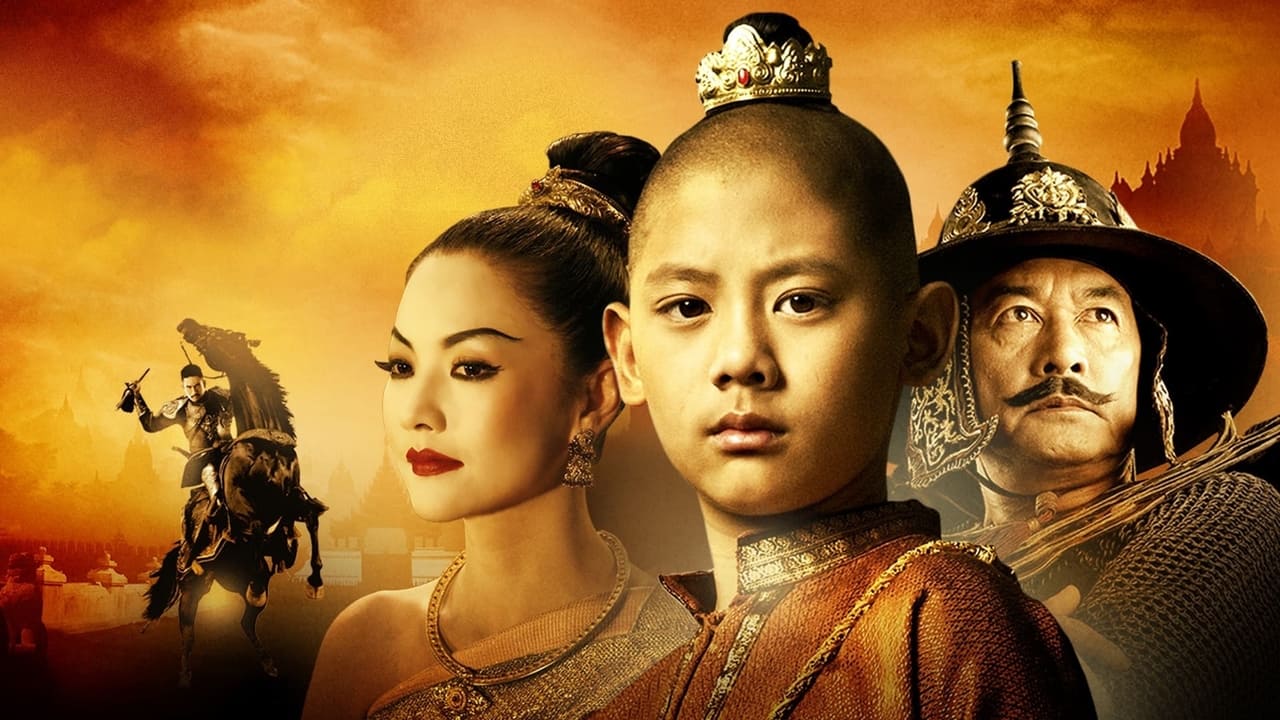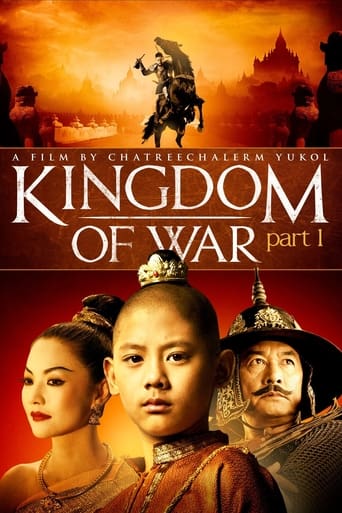

"Kingdom of War"--which was the title I saw it under in a two-disc DVD set from Magnolia Home Entertainment--has some things going against it but a lot more going for it. For Westerners unfamiliar with Thai history, it gets a bit confusing because so many historical names and places are mentioned and the shifting political and military alliances change so often that it's hard to tell the players without a scorecard and, as other reviewers have mentioned, the acting is, at times, somewhat stilted. Also, I know that royalty is revered in Thailand, possibly more so than in other countries, but seeing the complete subservience of everyone to the various kings and lords--there were even scenes of people walking toward the king on their knees because apparently no one is allowed to stand taller than the king, something I'd never seen before--is somewhat hard for Westerners to take (we're much more comfortable cursing and swearing at our leaders than prostrating ourselves in front of them, as much as they'd no doubt probably like us to).That's all small potatoes, though. Overall, I enjoyed this film way more than I thought I would. It's an epic in every conceivable sense of the word--thousands of extras, huge and fantastic sets, beautiful costumes and interiors (palaces, throne rooms, etc.), and truly spectacular battle scenes. The story--after you finally figure out who is who--is fascinating and not all the acting is stilted; the actress who plays Princess Lekin is not only one of the most ravishingly beautiful women I've ever seen but gives a first-rate performance, possibly the best one in the film. The man who plays King Nerusuan--the Special Features section, which you should really watch, says he is actually a Thai Army colonel who was hired because the producers wanted someone with military experience to play one of Thailand's great military heroes--also contributes an excellent job, along with several other actors in lesser roles (the head monk and Prince Menechan, among others).As I said, it's a bit hard to slog through in the beginning, but once you get the different characters, kingdoms, etc., straightened out, it's an incredibly enjoyable film, both visually and story-wise. I recommend it.
... View MoreAfter seen two episodes of this movie, I can say it's better than Suriyothai in every aspect, especially in story telling. But it's still not good enough to give the audience of its full picture. Time in movie's confusing, at any moment, I couldn't know whether it'd been a day or a month. Just felt that people moved from city to city so fast. The film also spent significant time on side line stories that, IMHO, unnecessary. However, I like sound effect and music, it fitted nicely with many scenes. Especially, in episode 2, it gave great feeling in many battle scenes. Totally, I like this movie. I consider it as the best & great Thai movie for current time and hope to see it better in future time.
... View More"Suriyothai" told the story of Thailand's greatest ever heroine - a Queen who rode into battle on an elephant.When "Suriyothai" was released, it quickly broke all box office records in Thailand. However, internationally the film did not make much impact. Even after Francis Ford Coppola re-edited and re-released it, it did not attract significant attention.There are certain facts one should know in order to understand the popularity of "Suriyothai" in Thailand. 1. The Thai people love the royal family. They don't just respect the royalty, they feel a personal love for the King. 2. The director, known informally as 'Tan Muy' is a cousin of the King, quite high up in the rankings of the royal family. I have heard that when visiting the film set, some people would drop to the floor and lie prostrate in front of him - although I understand he is in fact very friendly, approachable and informal. 3. The story of "Suriyothai" is not only a story that every Thai schoolchild knows - but is an extremely symbolic story - one that touches the hearts of all Thai people. 4. Very few directors would be considered worthy of even attempting this story. A director would have to be very careful not to abbreviate or alter the plot for dramatic value. Retaining period detail and accuracy would be very important.But for a foreign audience with no appreciation of Thai royalty, Thai history, Thai politics or Thai culture, much of "Suriyothai" simply went over their heads.When one stripped away the cultural significance, what was left was a rather long film, with a plot sometimes difficult to understand, wooden acting, beautiful to look at, and some epic battle scenes.When judging "Naresuan" therefore, one has to accept that this film shares a lot in common with "Suriyothai". 1. It takes its plot from a famous episode from Thai history. 2. It is again the true story of a famous Thai royal who waged war against the Burmese (the historical enemy of Thailand) 3. It is directed by the same director. 4. It was produced with the support of the Thai Royal family. 5. Its plot has not been simplified for dramatic value, but contains a lot of characters all entwined in a complex way that might be unfathomable to a non-Thai audience. In fact, it is probably true to say that in every way it is like "Suriyothai" but more so. "Suriyothai" was long. 'Naresuan' is longer - in total around nine hours. "Suriyothai" was the most expensive Thai film ever made. "Naresuan" cost more than twice as much. "Suriyothai" broke box office records in Thailand. "Naresuan" after one week has already beaten those records.So, in writing a review of "Naresuan", it is very important to understand the film within its context, as a film that is so particularly 'Thai' that perhaps a Western viewer is incapable of looking at it from the same perspective.One problem with the depiction of Royal characters is that they must always be depicted with dignity, respect, aplomb. This means that in many scenes, the main characters are adopting stiff, regal poses which greatly limits their acting freedom.Similarly, many of the shots of throne-rooms are beautifully composed, perfectly lit, wonderfully detailed, but after repeated scenes, tend to feel rather static - like a series of beautiful formal portraits. Even when the camera moves, frequently dollying and craning, it is always with a certain formal grace.Thus, I think a Western viewer might criticise what could be seen as stilted performances and a very formal shooting style.One might argue that there are too many characters and that some of the complex royal politics are hard to follow. But of course, if one has set oneself the task of documenting a well-known period of history, it is almost impossible to edit characters and events for dramatic purposes.So, ultimately while it is perhaps easy to find fault with "Naresuan" from the perspective of Western film-making, I think one has to realise that it stands apart - as a particularly Thai phenomenon.I have one regret. MC Chatrichalerm Yukol - to use the director's proper name - will be remembered internationally and in Thai film history as the director of these big epic royal chronicles. But I can't help feeling that working within the restrictions of this genre has somewhat masked his true talent as a director. We all remember Sir David Lean for the grand spectacles of "Lawrence of Arabia" and "Dr. Zhivago", but for me an equally important film was "Brief Encounter", the story of an illicit romance between two people in a small town - not epic at all. Or how about Richard Attenborough - whose epic "Gandhi" attracted so much attention - but managed later to make "Shadowlands" - again a much smaller, more personal story. MC Chatrichalerm Yukol has made a number of ground-breaking films in the past tackling controversial subjects such as rural poverty and prostitution. In a way, I would rather swap all the grand spectacle of these royal epics for some of the real compassion and conviction of the earlier, smaller films.For me, the best scenes in "Naresuan" were not the scenes with thousands of extras and grand sets. They were the informal, playful scenes of the three children. Just as in the film the three children were outside the palace and free from the formal bonds, etiquette and royal protocol and could play, explore and develop, it felt like the director also enjoyed the same freedom in these scenes.It is important to note that "Naresuan" is a trilogy, and these comments are based on viewing only the first film.Paul Spurrier
... View MoreThe Legend of Naresuan was originally planned a one long epic film that would contain all the historically facts and fiction; however, later compromised by Momchao Chatrichalerm Yukol to be cut into three separate films; and hence crippled by this. The first film of the trilogy was planned to be an explosion of Siamese pride and euphoria, not only for its history, but also a revitalization of Thailand's decrescendo of its movie industry. The film overall was quite satisfactory, from the emotional flashbacks of how the great Siamese kingdom of Ayodhya was so easily and effortlessly relinquished; to the exhilarating scenes of the royally-endorsed cockfight between the Burmese heir-apparent's son's cock and Naresuan's. The witty scenes between Naresuan, his guiding monk, Boonthing, and Manichan add seriously need comic relief to the film; yet at the end of the film; most would agree that it was over all too abruptly; and are forced to tie up loose ends in possibly another six hours of storytelling. In short, engulf but unfulfilled trilogy-opening film.
... View More